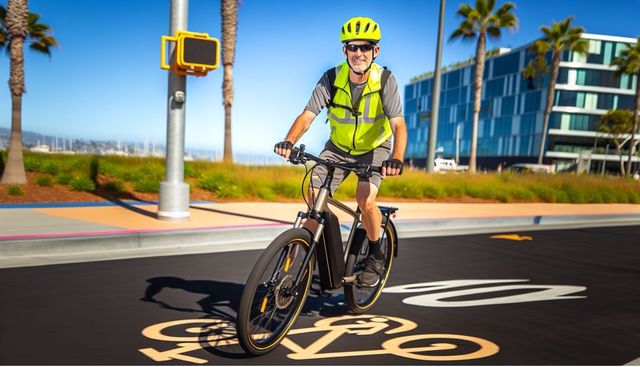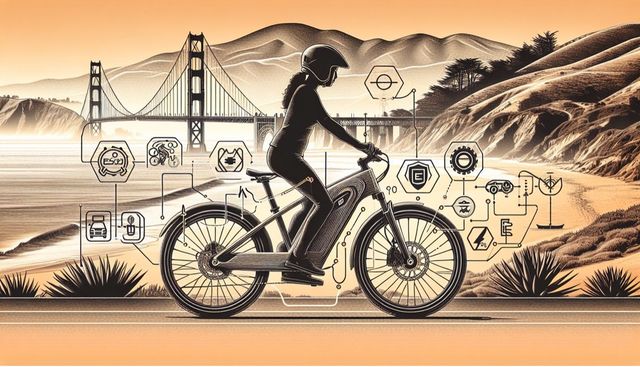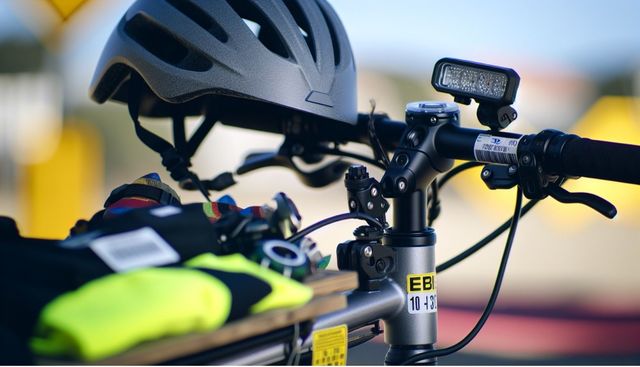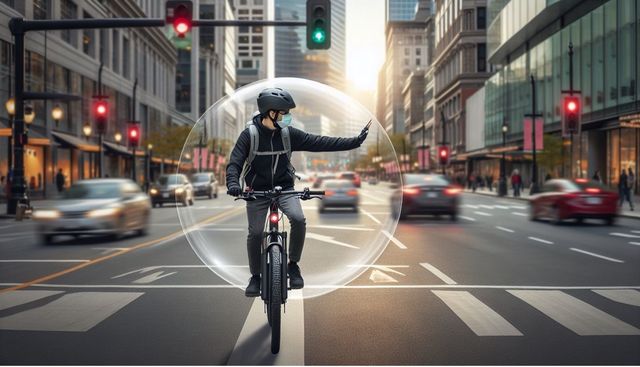Stephen Rosen • Feb 29, 2024
E-bikes are shaping the way Californians commute and explore, with nuanced regulations and emerging trends at the forefront of this evolution. Understanding the landscape of california ebikes is crucial, whether you’re a potential buyer or a current rider. This straightforward guide will walk you through the essential classifications, legalities, and practical insights, preparing you for a safe and enjoyable e-biking experience in the Golden State.
Key Takeaways
- California categorizes e-bikes into three classes with distinct features: Class 1 are pedal-assist with a 20 mph speed limit, Class 2 are throttle-controlled also with a 20 mph limit, while Class 3 are pedal-assist with a 28 mph limit suitable for faster commutes.
- E-bike riders in California must comply with legal requirements such as riding close to the road’s right side, following local ordinances on trails, and meeting age and helmet requirements (especially under-18s and Class 3 e-bike riders)
- To promote safety, California e-bikes must have motors not exceeding 750 watts, labeled with classification and specs, and equipped with safety gear for visibility. Routine maintenance and understanding accident risks are crucial for prevention.
Understanding California’s Electric Bike Classifications
In the Golden State, electric bikes are categorized into three distinct classes: Class 1, Class 2, and Class 3. Each class has its unique features and performance capabilities, making them suitable for different terrains and riding preferences. Grasping these classifications forms the cornerstone of a safe and satisfying e-bike ride, with each class adhering to distinct regulations and speed limits.
Class 1: Pedal-Assist Bikes
Class 1 e-bikes, commonly known as pedal-assist bikes, offer a unique blend of fitness and comfort. These e-bikes provide assistance only when you’re pedaling, with the assistance cutting off once you hit the speed of 20 mph. So, what’s the magic behind the pedal-assist mechanism? As you pedal, the system monitors your effort and signals the motor to provide the right amount of help, creating a harmonious blend of human power and electric assistance.
City streets to off-road trails, Class 1 e-bikes cater to a wide spectrum of terrains due to their versatility.
Class 2: Throttle-Controlled E-Bikes
Ever wished for a bike that gives you full power at the push of a button? Say hello to Class 2 e-bikes. With immediate access to full power without the need to pedal, these throttle-controlled e-bikes cater well to riders who prize flexibility. The throttle-control system, typically mounted on the handlebars, lets you control the bike’s speed, giving you the convenience of riding without pedaling when desired.
Like Class 1, Class 2 e-bikes in California also have a speed limit of 20 mph.
Class 3: Speedier Commuter Options
Designed for the fast lane, Class 3 e-bikes are the speediest of the lot. These e-bikes come with a motor that provides assistance only when you’re pedaling and cuts off when you hit the speed of 28 mph, making them suitable for quicker commutes.
The potent motor in Class 3 e-bikes empowers riders to attain higher speeds, facilitating quicker coverage of longer distances. So, if you’re someone who values efficiency and speed without breaking much of a sweat, Class 3 e-bikes could be your perfect commuting partner.
The Legalities of Riding E-Bikes in California

Just like conventional bicycles, e-bikes in California are governed by specific laws that dictate where and how they can be ridden. These laws encompass everything from riding on roadways, sidewalks, and bike paths to the age restrictions for riders. Complying with these laws not only safeguards your well-being but also helps dodge substantial penalties.
Navigating the Roadways
When it comes to riding e-bikes on roadways in California, there are specific rules you need to follow. For instance, e-bikes are required to ride as close to the right side of the road as practicable, with certain exceptions such as when preparing for left turns or when riding on a one-way street.
Furthermore, e-bike riders can share lanes with other vehicles, and they have access to Class 2 Bike Lanes and protected bike lanes, promising a seamless ride.
Trail and Bicycle Path Etiquette
Trails, including recreational trail options, and bike paths offer a unique riding experience, away from the hustle and bustle of city traffic. However, e-bike riders need to be mindful of specific rules and etiquette when using these paths. In California, the use of e-bikes on bike paths and trails is subject to local ordinances, and it’s essential to respect these rules to ensure a pleasant riding experience for everyone.
As on the roadways, e-bike users on trails and bike paths should adhere to identical regulations and exhibit courteous conduct towards other cyclists.
Essential Riding Regulations for E-Bike Enthusiast

Navigating the world of e-bikes involves understanding certain essential regulations. These rules encompass elements such as motor power, performance criteria, and safety measures, all critical to a secure and pleasurable e-biking experience.
Motor Power and Performance Standards
A key factor that differentiates electric bicycle, or e-bikes, from traditional bikes is their motor power. In California, e-bikes, also known as motorized bicycle, must have a motor power not exceeding 750 watts, ensuring a balance between performance and safety. Another important feature is the motor disengagement mechanism, which automatically turns off the motor when the brakes are applied, enhancing rider safety.
Motor power, measured in watts, impacts the e-bike’s speed and its capacity to navigate challenging terrains, rendering the electric motor a pivotal element of the e-bike’s performance.
Safety First: Helmet and Age Requirements
Safety is paramount when it comes to e-bike riding. In California, riders of Class 3 e-bikes and those under 18 years of age are required to wear a helmet. This safety measure plays a vital role in reducing the probability of head injuries during accidents.
Besides, there are certain age restrictions for e-bike riders. For instance, to operate a Class 3 e-bike, one must be at least 16 years old. These safety requirements are designed to protect riders and ensure a safe riding experience for everyone on the road.
E-Bike Equipment and Identification

Armed with the right equipment and proper identification, e-bike riders can ensure a safer and more enjoyable riding experience. From visibility and safety gear to e-bike labeling, these aspects play a crucial role in enhancing rider safety, ensuring compliance with regulations, and facilitating easier identification of e-bikes.
Visibility and Safety Gear
Visibility is key when it comes to road safety, and this rings true for e-bike riders as well. Using safety gear such as helmets, reflective clothing, and bike lights not only enhances your visibility on the road but also makes it easier for other road users to spot you, reducing the risk of accidents.
In addition, bike lights play a significant role in e-bike safety, especially when riding in low light conditions or at night.
Identification and Labeling
Proper e-bike identification and labeling are essential for ensuring compliance with state requirements. In California, e-bike manufacturers are legally required to affix a label to each e-bike, specifying its classification type, top assisted speed, and motor wattage.
These labels contribute significantly to e-bike identification, enabling riders and authorities alike to pinpoint the e-bike’s classification and performance attributes readily.
Avoiding Pitfalls: E-Bike Safety and Accident Prevention

While electric bicycles, also known as e-bikes, offer a fun and convenient way to get around, they also come with their unique safety considerations. Apprehending potential risks and adopting precautionary safety measures enable riders to steer clear of usual hazards, ensuring a safer journey.
Proactive Measures for Safe Riding
Routine check-ups of your e-bike significantly contribute to a safer riding experience. From maintaining proper tire pressure to regularly checking your brakes, these small steps can help prevent unexpected breakdowns and accidents. Similarly, taking care of your e-bike chain by cleaning and lubricating it regularly can enhance your bike’s performance and longevity.
Lastly, before you hit the road, ensure you’re equipped with the necessary safety gear and that your bicycle, equipped with an e-bike’s motor and battery, is in good working condition as a motor vehicle alternative.
Understanding E-Bike Accident Risks
A clear comprehension of the specific hazards related to e-bikes assists riders in maintaining safety on the road. For instance, e-bikes can reach higher speeds than traditional bikes, increasing the risk of e bike accidents with pedestrians and vehicles and the potential for severe injuries resulting from these impacts. Furthermore, the heavier weight of e-bikes can affect their maneuverability and stability, particularly when carrying heavy loads, making them more prone to accidents.
Comparing Traditional Bikes and E-Bikes
Choosing between a traditional bike and an e-bike can be a challenging decision. Traditional bikes serve fitness and leisure purposes well, however, with features like electric assistance and higher speeds, e-bikes prove to be a more adaptable choice for commuting and extended rides. Moreover, both types of bikes have a relatively low environmental impact, making them a green choice for transportation.
However, e-bikes can incur higher repair costs, although their operational costs are generally lower due to reduced maintenance needs and absence of fuel costs.
Summary
Navigating through the world of e-bikes in California involves understanding the unique classifications, adhering to the legalities of riding, and complying with essential regulations. Equipped with the right gear and proper identification, riders can ensure a safer and more enjoyable ride. While e-bikes come with their own set of risks, understanding these risks and being proactive about safety measures can help prevent accidents. Whether you prefer the simplicity of a traditional bike or the versatility of an e-bike, both options offer a unique and fun riding experience. Remember, the key to a great ride is safety, understanding, and respect for the rules of the road.
Frequently Asked Questions
Are e-bikes legal in California?
- Yes, e-bikes are legal in California and are subject to the same rules and legal requirements as traditional bicycles. It is important for riders to follow local traffic laws and obey posted speed limits.
What are the new ebike laws in California 2023?
- The new e-bike law in California 2023 allows electric bicycles in places they weren’t usually permitted before, preventing cities from restricting access to e-bike riders in certain areas.
Who is the owner of California eBikes?
- The owner of California eBikes is Brian Waters, as stated on his LinkedIn profile.
Does California offer a ebike rebate?
- Yes, California offers an ebike rebate of up to $2,000 through the California E-Bike Incentive Project, funded by the California Air Resources Board (CARB).
What safety gear is required for e-bike riders in California?
- E-bike riders in California are required to wear a suitable helmet, have front and rear lights on the bicycle, use reflectors on the wheels and pedals, and wear reflective clothing. All these safety measures are necessary for riding an e-bike in the state of California.

